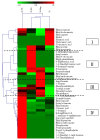The Sensory Quality Improvement of Citrus Wine through Co-Fermentations with Selected Non- Saccharomyces Yeast Strains and Saccharomyces cerevisiae
- PMID: 32110914
- PMCID: PMC7143248
- DOI: 10.3390/microorganisms8030323
The Sensory Quality Improvement of Citrus Wine through Co-Fermentations with Selected Non- Saccharomyces Yeast Strains and Saccharomyces cerevisiae
Abstract
Co-fermentation of selected non-Saccharomyces yeast strain with Saccharomyces cerevisiae is regarded as a promising approach to improve the sensory quality of fruit wine. To evaluate the effects of co-fermentations between the selected non-Saccharomyces yeast strains (Hanseniaspora opuntiae, Hanseniaspora uvarum and Torulaspora delbrueckii) and S. cerevisiae on the sensory quality of citrus wine, the fermentation processes, the chemical compositions, and the sensory evaluations of citrus wines were analyzed. Compared with those of S. cerevisiae fermentation, co-fermentations produced high sensory qualities, and S. cerevisiae/H. opuntiae co-fermentation had the best sensory quality followed by Sc-Hu and Sc-Td co-fermentations. Additionally, all the co-fermentations had a lower amount of ethanol and total acidity, higher pH value, and higher content of volatile aroma compounds, especially the content of higher alcohol and ester compounds, than those of S. cerevisiae fermentation. Therefore, co-fermentations of the non-Saccharomyces yeast strains and S. cerevisiae could be employed to improve the sensory quality of citrus wines. These results would provide not only methods to improve the sensory quality of citrus wine, but also a valuable reference for the selection of non-Saccharomyces yeast strains for fruit wine fermentation.
Keywords: Citrus wine; Co-fermentation; Non-Saccharomyces yeast strains; Sensory quality.
Conflict of interest statement
There are no conflicts of interest among the authors.
Figures



Similar articles
-
The impact of simultaneous inoculation with Torulaspora delbrueckii and Hanseniaspora uvarum combined with Saccharomyces cerevisiae on chemical and sensory quality of Sauvignon blanc wines.Front Microbiol. 2024 Jul 24;15:1413650. doi: 10.3389/fmicb.2024.1413650. eCollection 2024. Front Microbiol. 2024. PMID: 39113838 Free PMC article.
-
Effect of Hanseniaspora uvarum-Saccharomyces cerevisiae Mixed Fermentation on Aroma Characteristics of Rosa roxburghii Tratt, Blueberry, and Plum Wines.Molecules. 2022 Nov 21;27(22):8097. doi: 10.3390/molecules27228097. Molecules. 2022. PMID: 36432199 Free PMC article.
-
Torulaspora delbrueckii for secondary fermentation in sparkling wine production.Food Microbiol. 2018 Sep;74:100-106. doi: 10.1016/j.fm.2018.03.009. Epub 2018 Mar 19. Food Microbiol. 2018. PMID: 29706323
-
The Whiff of Wine Yeast Innovation: Strategies for Enhancing Aroma Production by Yeast during Wine Fermentation.J Agric Food Chem. 2019 Dec 11;67(49):13496-13505. doi: 10.1021/acs.jafc.9b06191. Epub 2019 Nov 25. J Agric Food Chem. 2019. PMID: 31724402 Review.
-
The impact of Torulaspora delbrueckii yeast in winemaking.Appl Microbiol Biotechnol. 2018 Apr;102(7):3081-3094. doi: 10.1007/s00253-018-8849-0. Epub 2018 Feb 28. Appl Microbiol Biotechnol. 2018. PMID: 29492641 Review.
Cited by
-
Isolation, identification, and tolerance analysis of yeast during the natural fermentation process of Sidamo coffee beans.Arch Microbiol. 2024 May 28;206(6):279. doi: 10.1007/s00203-024-04017-0. Arch Microbiol. 2024. PMID: 38805051
-
Comparison of physicochemical, phytochemical, and volatile profiles, and bioactivities of citrus wines brewed from different varieties.Food Chem X. 2025 Jul 2;29:102726. doi: 10.1016/j.fochx.2025.102726. eCollection 2025 Jul. Food Chem X. 2025. PMID: 40686885 Free PMC article.
-
Biodiversity and Winemaking Characteristics of Yeasts Isolated from Docynia delavayi (Franch.) Schneid. Wine Microbiota.Foods. 2025 Feb 7;14(4):553. doi: 10.3390/foods14040553. Foods. 2025. PMID: 40001997 Free PMC article.
-
Interaction and Application of Molds and Yeasts in Chinese Fermented Foods.Front Microbiol. 2022 Apr 8;12:664850. doi: 10.3389/fmicb.2021.664850. eCollection 2021. Front Microbiol. 2022. PMID: 35496819 Free PMC article. Review.
-
Effects of Non-Saccharomyces Yeasts and Their Pairwise Combinations in Co-Fermentation with Saccharomyces cerevisiae on the Quality of Chunjian Citrus Wine.Molecules. 2024 Feb 27;29(5):1028. doi: 10.3390/molecules29051028. Molecules. 2024. PMID: 38474538 Free PMC article.
References
-
- Gao Y., Kan C., Chen M., Chen C., Chen Y., Fu Y., Wan C., Chen J. Effects of Chitosan-Based Coatings Enriched with Cinnamaldehyde on Mandarin Fruit cv. Ponkan during Room-Temperature Storage. Coatings. 2018;8:372. doi: 10.3390/coatings8100372. - DOI
-
- Liu R., Zhang Q., Chen F., Zhang X. Analysis of culturable yeast diversity in spontaneously fermented orange wine, orange peel and orangery soil of a Ponkan plantation in China. Ann. Microbiol. 2015;65:2387–2391. doi: 10.1007/s13213-015-1081-6. - DOI
Grants and funding
LinkOut - more resources
Full Text Sources
Molecular Biology Databases

